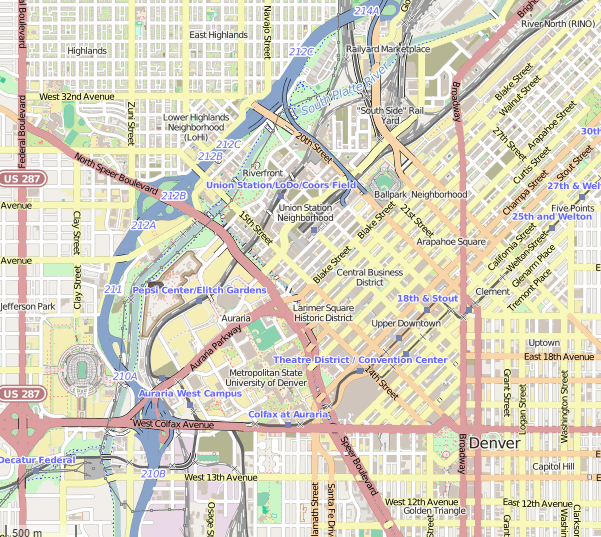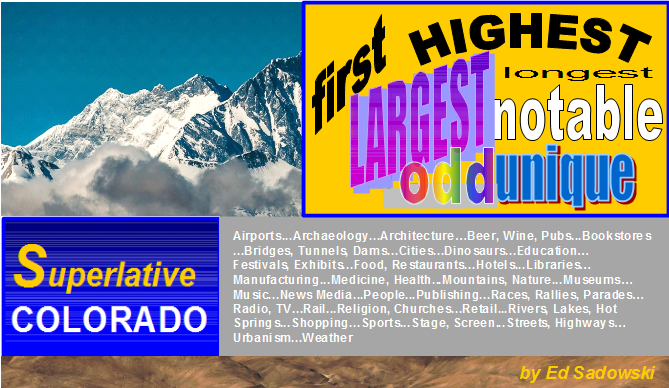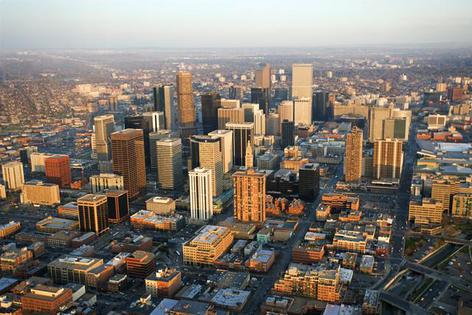Map: © OpenStreetMap contributors
Another Ed Sadowski creation
ED SADOWSKI
Streets, Bridges,
Infrastructure
Airports...Archaeology...Architecture...Art...Beer, Wine, Pubs... Bookstores...Bridges, Tunnels, Dams...Churches, Religion... Cities... Dinosaurs... Education...Events, Festivals...Food, Restaurants..Hotels... Libraries... Manufaturing...Health, Medicine...Mountains, Nature... Museums... Music...News media...People...Publishing...Races, Rallies, Parades...Radio, TV...Rail transit...Retail...Rivers, Lakes, Hot Springs...Sports...Stage, Screen...Streets, Highways, Infrastructure... Urbanism...Weather, Climate
Downtown
Denver
.
STREETS, BRIDGES
16th Street Mall
19th Street Bridge
Blake Street
Colfax Avenue
Colfax-Larimer Viaduct
Curtis Street
Denver Millennium Bridge
Denver Steam Plant
Larimer Street
Market Street
Welton Street
Wynkoop Street
16th Street Mall ////////////////////////////////////////////////
When most pedestrian malls have failed, the 16th Street Mall is one of the country’s most enduring and successful: also one of the longest at 1.42 miles (2.3 km) long, most of it pedestrian- and transit-only. The Mall stretches from Broadway Avenue to the Millennium Bridge (from which another two bridges connect pedestrians over railroad tracks and I-25 to Highland).
Designed by the renowned architect I.M. Pei, the Mall opened in 1982, and has been lauded by the Urban Land Institute. It is lined with over 150 restaurants, outdoor cafes, boutiques and retail centers Denver Pavilions and Tabor Center, and it runs one block from Larimer Square. It has over 200 trees, unique lighting fixtures and “carpet-runner” red, white and gray granite pavers resembling a rattlesnake’s back.
At one time 16th Street, the “main street of downtown,” with multiple department stores, was the city’s retail center before the advent of suburban shopping malls. It was this street that boasted the world’s largest Woolworth’s variety store, part of the Rocky Mountain region’s premiere shopping experience. While the street’s oldest retailers have moved away or gone out of business, a few remnants have stayed, such as the nation’s fourth oldest Walgreen’s, still at its same location since 1949.
19th Street Bridge ///////////////////////////////////////////
The historic 19th Street Bridge is the oldest bridge in the western US outside of the West Coast. It spans the South Platte River adjacent to 19th Street. Built in 1888, the bridge replaced a wooden structure damaged from flooding of the Platte. It is one of the few remaining cast iron bridges remaining in the US, a pin-connected, five-panel, two-span Pratt through truss design, with unusually deep I-beam upper struts. Its beautiful design has cast iron newels and latticework on the cantilevered sidewalks, and embellished finials and cresting on either end.
In 1904 a plan to rebuild the bridge as an extended viaduct was defeated. Mostly unmodified since construction, the original timber decking was replaced with asphalt and corrugated steel following a 1961 flood and some bent hinges were replaced as a result of a 1965 flood.
The original settlers in the area of the 19th Street Bridge were German immigrants, who found the river location convenient for them to do their laundry.
The bridge carried automobile traffic until 1986. Because of repeated wear and deterioration caused by salt for melting ice, the bridge was restricted to pedestrians and bicycles after 1986. In 1992 a 19th Street vehicular bridge was built upstream over the Platte, just northeast of the original bridge.
In the state of Colorado, the 19th Street Bridge is the oldest surviving wrought iron bridge, oldest vehicular bridge at its original location, and oldest vehicular bridge still in public use.
Since 2011 the historic bridge has been an unusual event venue—for the annual Greenway for the Blue Moon After Party on the Bridge.
Blake Street ///////////////////////////////////////////////////////////
Superlatives: A rarity of extant commercial buildings built in the 1860s, including one owned by black trailblazer Barney Ford, the first African American to serve on a US grand jury, the first African American to be listed in the Denver Social Register--among the first, or possibly the first, in the country to be so listed. At 19th, the superlative National Baseball Museum; at 20th, superlative Coors Field.
If really, really "old" intrigues and awe-inspires you (Europeans, of course, will roll their eyes at this sort of American pride), then, take note: while walking down the 16th Street Mall there are street corners from which you can take a few steps and gaze at almost the oldest group of commercial buildings anywhere in the country. We're talking about the remarkable rarity of still-standing downtown buildings built in the 1860s, a distinction that even eastern cities like Chicago and Atlanta can't match. (In the West, San Francisco's Jackson Square, however, has about a dozen buildings from the 1850s.)
These buildings are the nondescript, oldest remnants of Denver's first brick buildings, so unobtrusive and practically invisible that passersby don't notice these preserved treasures, much less are aware of their significance. These buildings are easy to identify as they are long and narrow, with rounded arches on the front facade. These structures were built in 1863, immediately after the Great Fire of 1863 had destroyed most of Denver's wooden buildings. As a result, Denver passed one of the first ordinances requiring buildings to be built of brick or stone, in place un til the 1940s. Take a brief look at these extant narrow brick storefronts on the south side of Blake Street, at 1514, 1516, and 1526.
The Barney L. Ford Building at 1514 Blake was owned by the remarkable Barney Ford (1822-1902), a Virginia-born slave who grew up without a last name. He escaped on the Underground Railroad to freedom in Chicago, where he briefly lived and got married. His wife Julia helped him choose a surname when one day Barney saw a locomotive named Lancelot Ford, which then became his middle and last name.
After travels to California and Nicaragua, he rose to become one of the wealthiest men in Colorado, prominent as a brilliant entrepreneur, civic leader and civil rights activist. He opened the People's Restaurant and several other businesses at that location in 1863, in a building that had replaced his barber shop that had burned down at that location.
He was the first African American to serve on a U.S. grand jury and was nominated for the Territorial Legislature. In 1898 he was the first African American to be listed in the Denver Social Register, among the first, or possibly the first, in the country to be so listed. He is honored with a portrait on a stained glass window in the State Capitol Building.
Colfax Avenue ////////////////////////////////////////////////
Colfax Avenue, abutting the State Capitol and slicing through downtown Denver, lays claim to being the longest continuous commercial street in the US.
From the plains westward to the foothills, its length is commonly given as 26.8 miles, but, using another measurement, stretches a total of 53.3 miles.
Colfax can be thought of as the east-west spine of Denver. The street was once known as the “gateway to the Rockies,” is part of US Route 40, traversing from the east to west coasts—at one time carrying more automobiles than any other transcontinental highway.
The central portion of the thoroughfare started as a six-block street of mansions in what is now Capitol Hill, first called Grand Avenue in 1864, then renamed for Schuyler Colfax, vice president of the United States under Ulysses S. Grant.
Today, beyond the Denver city limits, East Colfax can be thought of as the original "Main Street" of Aurora and West Colfax as the original "Main Street" of Lakewood, stretching further west as far as Golden.
Colfax-Larimer Viaduct ////////////////////////////////
GONE INTO HISTORY
When completed in 1917, the Colfax-Larimer Viaduct was the longest concrete span of its kind in the world: nearly a mile and a half of reinforced-concrete structure.
The Larimer viaduct connected the central business district to the railroad yards, while the longer Colfax viaduct, including a steel span over the South Platte River, reached west Denver. The viaduct consisted of a series of arches and cantilevers designed to handle the problematic expansion and contraction of the viaduct caused by heat and cold.
A forgotten part of Denver lay underneath the Colfax Viaduct—which from the late 1800s through the 1950s was home to cigar stores, bicycle shops, churches, grocery stores, hay markets and midwives. Eastern European Jews and Italians first lived there, followed by Mexican immigrants. Many of the homes and businesses were wiped away with the coming of the Valley Highway, or I-25.
By the early 1980s, 35,000 vehicles crossed the viaduct daily, which was in need of repair. The original viaducts were demolished and replaced in 1983 by the present Colfax Viaduct and Auraria Parkway.
Curtis Street ///////////////////////////////////////////////////////////
Superlatives: "The best lighted street in the world," according to Thomas Edison; the second "Great White Way," second only to Times Square.
Curtis Street was synonymous with movie houses. The strret's first association with theater began with the Apollo Hall, Denver's first, in 1859. In 1881 the Tabor Grand Opera House was built at the corner of Curtis and 16th, drawing the world's best performers and productions. In the early 1900s, there were numerous theaters in Denver, both downtown and in the neighborhoods. The theaters featured everything from peepshows to girlie, variety, and burlesque shows, as well as vaudeville and stock theater.
By 1925, at least 13 vaudeville and movie houses lined both sides of Curtis Street, becoming known as Denver's theater row. That same year Thomas Edison called Curtis Street, the "best lighted street in the world." Curtis Street had become the second White Way, becoming the West's Times Square.
Later, talking motion pictures took over the venues, and cinemas were built in other parts of downtown and the suburbs. As cinemas spread to the rest of Denver and its suburbs, by the 1950s the Curtis Street theaters were reduced to showing B movies, and eventually disappeared, together with most of the other downtown cinemas, thanks to urban renewal in the 60s and 70s.
Denver Millennium Bridge /////////////////////////////
At the north end of the 16th St. Mall, near Union Station
Superlative: A uniquely-built footbridge, the world's first cable-stayed bridge using post-tensioned structural construction.
You are at the end (or the beginning) of downtown's 16th Street. The Millennial Bridge connects the 16th Street Mall with Commons Park in the Central Platte Valley District of the Union Station neighborhood. The $9 million bridge, completed in 2002, is the first of a distinctive trio of closely-placed pedestrian bridges between downtown Denver and the Highland district.
The 130-foot walk across the bridge takes you over the railroad tracks and the regional light rail system. You get a different kind of view of downtown Denver as well as the South Platte River.
The bridge stands out as one of the most striking superlatives you'll encounter anywhere, actually impossible to miss if you're anywhere close to it: an imposing tilted white tapered steel structure juts out like a ship's mast, 200 feet high, connected by steel cables to the bridge deck and foundation anchors.
The structural assignment of spanning 130 feet (40m) without a steep increase in elevation was truly a challenge. The designers brilliantly figured out how to minimize the climb to no higher than 25 feet above street level, with the incline so gradual, it almost fools you. One trick to evade a steep elevation was making the deck as thin as possible (6-inch-thick reinforced concrete slab-on-metal deck, supported by secondary I-beams), while remaining stable, made possible by what is called post-tensioned construction. Stiffness and supportive tension is achieved with a single mast tilted toward one end of the bridge, created by using the mast as a lever to pull the deck up into a shallow arc, keeping the opposite end of the bridge secured by two steel rods.
Glass-enclosed elevator towers on both ends of the footbridge accommodate pedestrians without having to climb the stairs leading up to either end of the bridge from street level.
Denver Steam Plant
19th and Wewatta (NW corner)
Superlative: the oldest continuously-operated commercial district heating system in the world
The steam plant was originally built in 1880, one of the first commercial district steam systems (the first one was started in Lockport, NY in 1877). The centralized system replaced the use of individual on-site boilers in buildings because of safety problems and dangers of explosion of increasingly higher-pressure boilers used for operating elevators and other power machinery.
The steam plant is a hub of a network of over 16 miles of underground steam pipes to over 130 customers in the downtown area, providing space heating and domestic hot water. The gold-colored facility, operated by Xcel, was rebuilt in 1972 and services many of downtown's largest office buildings and major cultural, government, and civic facilities. In 1998, the system added chilled-water cooling to its portfolio of services.
Larimer Street ///////////////////////////////////////////////////////
Superlatives: Formerly one of America's most infamous skid rows; Larimer Square, "Denver's most historic block," a national model for urban revitalization, one of the first preservation projects of its kind.
Larimer is Denver's first main street. The street was named after General William Larimer (1809-1875), the Kansas politician and land developer who was the founder of Denver. Between 15th and 16th Streets Larimer built Denver's first cabin in 1858; its doors were made from coffins.
Between 14th and 15th Streets is Denver's Larimer Square, a restored block that's been a national model for how to preserve, not tear down, rotting downtowns, thanks to pioneering developer Dana Crawford. Today's thriving LoDo is the resulting outgrowth of this single urban revival. Current Larimer Square tenants include The Comedy Works, named by USA Today as one of the top five comedy clubs in the nation.
Market Street ///////////////////////////////////////////////////
Superlatives: Curious multiple name changes; the street with the double-entendre name; “the wickedest street in the West’s most sinful city;” home to a few structures that are the oldest brick buildings in the West, outside of the West Coast; location of the oldest jazz club west of New Orleans.
Market Street was the center of the red light district in Denver's earliest days. Cheap hotels, opium parlors, and elaborate bordellos lined the street, with signs advertising such things as “Men taken in and done for.” The legendary madam and brothel keeper Mattie Silks' (1846-1929) first establishment of ill repute was located a few blocks up the street by 20th Street. Sure, Denver wasn't the only city claiming to have the wickedest street, but being almost the biggest city in the West (next to San Francisco), the boast carried extra weight.
This street was originally McGaa Street, named after the Scottish-born mountain man, William McGaa (c. 1820s-1866). McGaa camped on the bank of Cherry Creek with his Arapaho native wives, and claimed aristocratic ancestry, as well as dubious authority of land transfer matters. One of his two children is noted for being the very first white child to be born in Denver, in 1859.
McGaa had a shady reputation and was known as the town drunk, so after his death in 1866, McGaa Street was renamed Holladay St. in honor of the much admired Overland "Stage Coach King" magnate Ben Holladay (1819-1887), who brought his stage line to Denver (whose headquarters was on the southwest corner of 15th and Market).
But eventually the Holladay family did not want their name on this morally sullied street, and in 1889 McGaa Street was renamed Market St. The irony of the name was not lost to the respectable residents a few blocks east at 23rd (Park Ave.), and did not want the word Market as part of their address. So that explains why the northern stretch of Market Street was renamed to the more innocent-sounding Walnut Street, one of the rare instances where adjacent continuous streets have two different names.
At 20th Street is El Chapultepec, the oldest jazz club west of New Orleans.
Welton Street ///////////////////////////////////////////////////
Superlatives: The Welton Street line was the world’s longest cable car line, part of America's most extensive cable car tramway networks.
The city fathers initiated a move to public transportation in Denver in 1867, but it was not until 1871 when the first line, consisting of horse-drawn trolleys, was put in place by the Denver Horse Railroad Company. The horse-drawn cars were replaced by cable tramways, with one of America's most extensive cable car networks, operated by the Denver City Cable Railway. Its Welton Street line was the world’s longest cable car line. The Welton Street line opened in November, 1889, coursing from 16th and Welton to 30th Street to 28th Avenue to Gaylord Street to 38th Avenue. Other lines were the Larimer Street, 17th Street, 17th Avenue, and West Denver (11th Street). The company later became the Denver City Railway Company, went bankrupt and was taken over by Denver Tramway, which by 1900 converted the system to electric.



